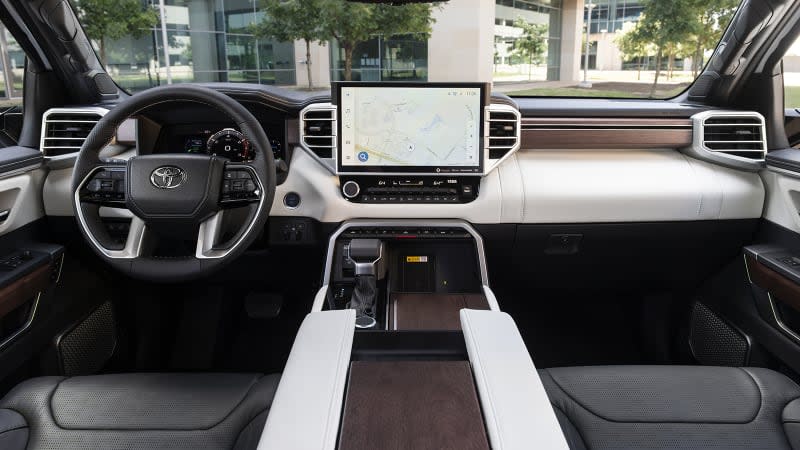2024 Toyota Sequoia Review: Big and powerful, but very compromised

Pros: Cool TRD Pro trim level; potential above-average fuel economy; competitive towing capacity
Cons: Poor cargo space; iffy value; Capstone’s teeth-chattering ride; comparatively cumbersome handling; irksome tech
If you’re looking for an SUV that’s big, powerful and definitely looks big and powerful, the 2024 Toyota Sequoia will get the job done. Its TRD Pro trim level also brings its big and powerful game off-road, where it can tackle terrain nothing else in the full-size SUV segment is likely to dare. And if you want the promise of longevity and resale value that Toyota has long offered, well, the Sequoia should deliver that, too.
The trouble is, if you’re looking for a big and powerful SUV to provide more people and cargo-hauling capabilities than a big crossover like Toyota’s new Grand Highlander, you’re going to be sorely disappointed. Redesigned last year, the latest Sequoia generation is actually smaller than its predecessor with a solid rear axle that robs it further of interior space and hampers both the handling and ride (the old Sequoia had an independent rear end like the Ford, GM and Jeep full-sizers). Put simply, third-row space and cargo capacity are uncompetitive. We’ve also found the handling to be cumbersome, even by full-size SUV standards, and the ride quality shockingly bad on the range-topping Capstone trim. Lower trims are better, but don’t rise to the level of competitors.
So yes, the Sequoia will work for those who really only need five seats and want a big, powerful rig … but we think most can do a lot better than that for basically the same price.
Interior & Technology | Passenger & Cargo Space | Performance & Fuel Economy
What it's like to drive | Pricing & Trim Levels | Crash Ratings & Safety Features
What's new for 2024?
A new Nightshade package arrives for the Limited trim level, swapping black exterior trim for the standard alloy and chrome. The TRD Off-Road package can also now be added to the Platinum trim level, bringing its Bilstein shocks and springs to a ritzier trim level. Finally, the Sequoia is nearly $3,000 more expensive this year, including the $1,850 obligatory destination charge that went up by $255. You don’t actually get anything more for that $3,000, either.



What are the Sequoia interior and in-car technology like?
The Sequoia shares its cabin design with the Tundra full-size truck. It really doesn’t suffer for that fact in terms of aesthetics, but it perhaps explains why you’ll find a few more hard plastics inside than a Chevy Tahoe or Jeep Wagoneer. Upper trim levels do spruce things up, including the TRD Pro’s unusual red camouflage print seats (below) or the Capstone’s ritzy combination of open-pore wood trim, black seats and white leatherette interior trim (above).
Standard on most trim levels is an enormous 14-inch touchscreen (the base SR5 gets an 8-inch unit). The operating system is the newest Toyota has to offer, featuring bright, minimalist graphics and natural speech recognition. It's responsive and runs quickly. The shortcut icons on the side closest to the driver are easy to reach, but they unfortunately disappear when you use Apple CarPlay or Android Auto, meaning you have to click-click-click to escape the Apple/Android interfaces rather than using a simple Home button like Toyota used to feature. There are other annoyances we discovered, including some radio functionality and a navigation system that defaults back to point-forward every time you move off the map screen, as if it can’t possibly contemplate someone wanting to consistently use North UP. All told, the system is less user-friendly than what you’d find in a Tahoe/Yukon, Expedition, Wagoneer and their luxury variants.


How big is the Sequoia?
As a full-size SUV, the Sequoia is obviously enormous on the outside compared to a crossover like the Highlander or even an SUV like the 4Runner. It is smaller than its American full-size SUV competitors on the outside, however, and packaging issues at the rear make it even smaller inside. Quite simply, the Sequoia’s third-row seat and cargo area are not competitive.
While fully grown teens and adults can comfortably fit for hours in the third row of a Tahoe/Yukon, Expedition or Wagoneer, the Sequoia is best suited to those of smaller stature, and even then for shorter trips only. It’s more akin to what you’d find in a three-row crossover, albeit with a higher step-in height. Now, it does uniquely slide fore and aft, but that’s more for the sake of cargo space.
Despite that feature, cargo space is extremely compromised. The biggest issue is that the third row does not fold flat into the floor as its competitors’ do, nor can it be removed. The result is basically a stage for your belongings that requires a significant lift and lean in to reach. With the third-row in use, space shrinks to a degree bested by most large three-row crossovers, including the new Grand Highlander. And true, you can slide that third row forward to free up extra space, but you’re just shrinking the third row even further and the result still falls short of what you can fit in the American competitors. Toyota at least came up with a clever multi-level cargo floor and partition system, but this largely seems like a workaround for a fundamental flaw.
What are the Sequoia fuel economy and performance specs?
Every Sequoia gets a hybrid powertrain dubbed i-Force Max. It consists of a 3.5-liter twin-turbo V6 and a single electric motor sandwiched between the engine and a 10-speed automatic transmission. It is a fundamentally different design than Toyota’s traditional, efficiency-oriented hybrids. Indeed, while the Sequoia does achieve above-average EPA fuel economy estimates, its performance benefits are the bigger deal: 437 horsepower and 583 pound-feet of torque. Torque in particular betters its gas-powered GM, Ford and Jeep rivals. Its 9,520-pound towing capacity also eclipses them.
Fuel economy also bests them at 21 mpg city, 24 mpg highway and 22 mpg combined with standard rear-wheel drive, or 19/22/20 mpg with optional four-wheel drive. In the real world, however, we didn’t come remotely close to that, averaging around 16 mpg in a mix of highway and suburban driving. The GM and Ford SUVs were thriftier.

 Yahoo Autos
Yahoo Autos 

